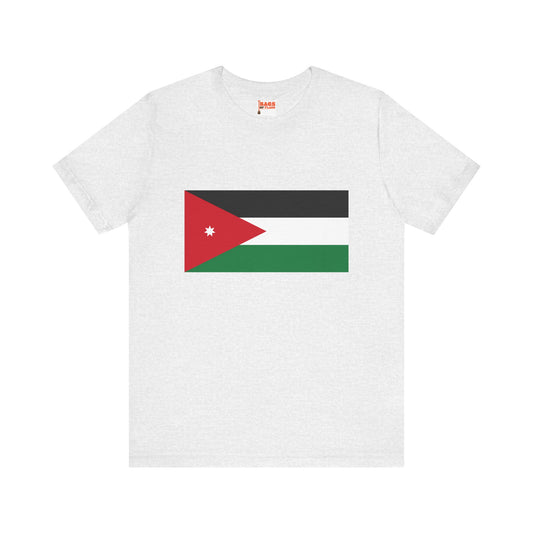-
Jordan Flag Sweatshirt
Regular price $34.15 USDRegular priceUnit price / per -
Jordan Sweatshirt
Regular price $34.15 USDRegular priceUnit price / per -
Jordan Pillow
Regular price $22.65 USDRegular priceUnit price / per -
Jordan Backpack
Regular price $59.79 USDRegular priceUnit price / per -
Jordan Leather Patch Hat
Regular price $18.85 USDRegular priceUnit price / per -
Jordan Mug
Regular price $11.65 USDRegular priceUnit price / per -
Jordan Trucker Cap
Regular price $14.90 USDRegular priceUnit price / per -
Jordan Hoodies
Regular price $34.40 USDRegular priceUnit price / per -
Jordan T-shirts
Regular price $22.79 USDRegular priceUnit price / per -
Jordan Flag Hoodies
Regular price $34.40 USDRegular priceUnit price / per -
Jordan Flag on T-shirt
Regular price $22.79 USDRegular priceUnit price / per
Collection: Jordan
The Jordan flag symbolizes national pride and unity for the people of Jordan. With its unique design and colors, the flag holds significant historical and cultural importance. We will examine the Jordan flag, exploring its design, symbolism, historical context, current relevance, and additional interesting facts.
Overview of the Jordan Flag

At the core of Jordan's national identity lies its flag, characterized by its distinctive design and vibrant colors. The flag features three horizontal black, white, and green bands, topped by a chevron-shaped red triangle at the hoist side. Nestled within this red triangle is a seven-pointed white star, a detail-rich in symbolic meaning. The dimensions of the flag maintain a ratio of 1:2, ensuring a visually balanced display. This configuration of colors and symbols is not only a representation of the nation’s heritage but also an emblem of unity and pride for its people. The juxtaposition of the colored stripes with the red triangle and white star creates a striking visual contrast, making the Jordan flag instantly recognizable and a significant marker of Jordanian sovereignty on the global stage.
Historical Context of the Jordan Flag
The inception of the Jordan flag can be traced back to a pivotal period in the early 20th century, marking a significant departure from Ottoman rule and the rise of Arab nationalism. Officially adopted on April 16, 1928, its design pays homage to the Arab Revolt flag of 1916, a powerful symbol during the uprising against the Ottoman Empire that spanned the Arab world. This revolt was a turning point in Arab history, fostering a sense of unity and national identity among the disparate Arab states. The addition of the seven-pointed star in the Jordan flag further imbues it with a unique identity, representing the seven verses of the first surah in the Quran, Al-Fatiha, and reflecting the nation's deep Islamic heritage.
This flag has flown through several key moments in Jordan's history, witnessing the country's evolution from a British mandate to an independent sovereign state in 1946. Over the years, the flag has remained a constant emblem of Jordan's enduring legacy and aspirations. Although it has seen modifications, the essence of its original design continues to stand as a testament to Jordan's rich history and its role in the broader Arab narrative. The flag's longevity and consistency highlight its importance not just as a national symbol but as a marker of Jordan's place in the historical and cultural tapestry of the Middle East.
Symbolism Behind the Jordan Flag

Each element of the Jordan flag is steeped in profound symbolism, reflecting the country's rich cultural heritage and historical narratives. The black band atop the flag represents the Abbasid dynasty, known for its Islamic Golden Age, while the white band echoes the Umayyad dynasty, underlining the era of Islamic expansion. The green band, closest to the flag's bottom, commemorates the Fatimid dynasty, signifying Islamic tolerance and unity.
The striking red triangle is a tribute to the bloodshed during the Great Arab Revolt, symbolizing the struggle for freedom and independence from the Ottoman Empire. At the heart of the triangle sits a seven-pointed star, each point representing one of the verses from the Quran's first surah, Al-Fatiha, an emblem of faith and enlightenment. This star further signifies the unity of the Arab peoples, encapsulating the ideal of solidarity among the diverse Arab nations. Together, these elements embody the foundational principles of freedom, unity, and faith that underpin the Jordanian identity, serving as a daily reminder of the nation's enduring legacy and aspirations.
Current Relevance of the Jordan Flag
The Jordan flag continues to hold a pivotal role in the country's national identity and is prominently featured in various contexts today:
- National and Military Events: The flag is central to national holidays, such as Independence Day. It is displayed in military parades and ceremonies, underscoring its significance in celebrating Jordan's sovereignty and honoring its armed forces.
- Official Functions and International Representation: The flag flies high at embassies around the world, symbolizing Jordan's presence on the international stage. It also adorns governmental buildings, serving as a symbol of authority and governance.
- Public Pride and Cultural Identity: Jordanians proudly display the flag during sports competitions, cultural festivals, and significant public gatherings. It acts as a unifying symbol, bringing together Jordanians from diverse backgrounds in a collective expression of national pride.
- Educational Contexts: Schools and educational institutions use the flag to instill a sense of national identity and historical awareness among students, emphasizing its importance from a young age.
Despite its widespread use and symbolic importance, the Jordan flag has also been the center of discussions and occasionally controversies. These typically revolve around its historical implications and the extent to which it represents all facets of Jordanian society. Such debates highlight the flag's role in ongoing national identity, heritage, and unity dialogues.
Additional Facts About the Jordan Flag
Beyond the symbolism and historical importance, the Jordan flag is subject to specific protocols that underscore its significance. Individuals handling the flag must ensure it remains aloft and clear of the ground as a mark of respect for the nation's emblem. The daily ritual of raising and lowering the flag is observed meticulously, signifying the beginning and end of each day with a gesture of national pride. Moreover, during mourning or to commemorate a national tragedy, the flag is flown at half-mast, serving as a solemn reminder of the observed event.
Interestingly, in 1985, a subtle but notable adjustment was made to the flag's design; the red triangle was realigned slightly towards its center, enhancing its aesthetic balance and visual impact. These protocols and adjustments, while may seem minor, play a crucial role in how the flag is perceived and respected both within Jordan and by the international community, further cementing its place as a vital symbol of the nation's identity and heritage.






















